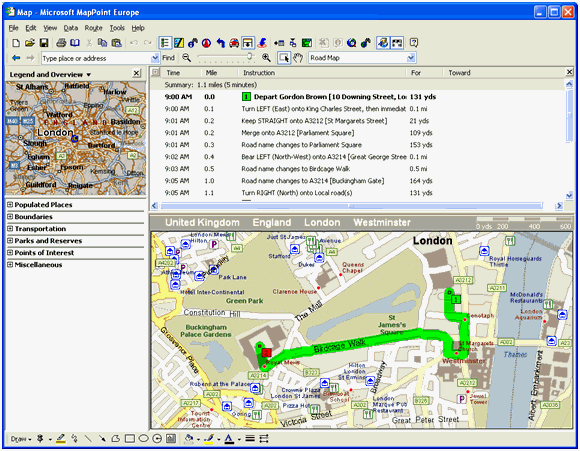 |

|
|
|
Calling MapPoint from C# with Late BindingRichard Marsden shows how to call MapPoint from C# using late binding or dynamic invocation. Late binding has a number of advantages in certain scenarios including being about to support multiple type libraries.
There are a number of articles on MP2K Magazine about using MapPoint from a variety of different languages. Most if not all of these articles use early binding to reference the MapPoint COM objects, because this is usually the easiest way of working with COM and it tends to be safer due to compiler checking. Early binding is also slightly faster due to all the references being hard-coded. However there are times when late binding might be more appropriate. This article shows you how to call MapPoint from C# using late binding. Late binding is also known as "dynamic invocation".
Early and late binding refer to how the code refers to the MapPoint COM objects. Early binding is performed at compile time and is essentially 'hard-coded'. Eg.
The compiler knows how myApp is defined, and can check the "Version" property exists. To do this, you must have a type library file for the COM objects being called. However, you might not have this type library, or you might want to support multiple type libraries. In this case, you have to write code which checks the interface of the COM object, and makes the call at run time. The above line becomes:
This is obviously a lot longer and more complicated! However, note that the property name is defined as string. This string could be changed at run time. The return type could also be changed at runtime without forcing an inappropriate cast to occur. So why would you want to use late binding, if it is so much work? Here are some possible reasons:
So let's see an example! This tongue-in-cheek example plans a road route through London for Gordon Brown's eventual trip to Buckingham Palace when he dissolves Parliament (Footnote: Gordon Brown’s popularity ratings currently make George Bush look like a popular President). To use late binding, you will need to add namespace references for System.Reflection and System.Runtime.InteropServices:
No MapPoint object definitions are available, so our MapPoint objects are all defined as generic objects:
Parameters are passed to MapPoint methods using arrays of objects. This sample only needs to pass one or two parameters at a time, so define these next. Note that these arrays can be re-used - we do not have to define new arrays for each and every method call.
Let's create a MapPoint instance. In order to create an object instance, we need a type. We obtain the type from a COM name by using Type.GetTypeFromProgID:
mp_app now contains a reference to the main MapPoint Application object. Properties and methods are invoked using the InvokeMember() method on the object's type. A BindingFlags value specifies the operation to invoke. We can read properties like so:
Similarly, we can write properties:
A parameter has to be passed when writing a property. We do this by setting a one element array to the value that we need to pass. More parameters could be passed (eg. to a method) by passing a longer array. Next we find two locations:
In both cases I have assumed that the first result is good. In a real application, you would check resultsQuality before reading the results collection (object fr). Next we fetch a reference to the Route object and the Waypoints collection:
In order to set the waypoints, we must pass two parameters to the waypoints object. This is performed using a two element array instead of the previous one element array. As an aside, it should be noted that all option parameters should be set. This is a good general rule for both early and late binding calls to COM from .NET.
Next we calculate the route, and fetch any results that we might require:
This is what MapPoint now looks like:

C# and .NET do a good job of garbage collection and cleaning up after COM. All you need to do is to set the object references to null, or to let them pass out of scope. You should still call the Application.Quit method to finally close MapPoint:
And that is it! Late binding is more complicated, and it lacks the safety net of compiler errors; but it can be very useful if you need to support multiple versions of MapPoint in .NET.
 Author: Richard Marsden Author: Richard MarsdenEmail: enquiries(AT)winwaed.com URL: http://www.winwaed.com Richard Marsden is the proprietor of Winwaed Software Technology, LLC which provides software consulting and development services, specializing in both MapPoint and online mapping applications. He operates the Mapping-Tools.com Website for MapPoint Tools and Utilities, and recently launched the GeoWeb Guru a community website for developers of the geospatial web. In 2008, Richard was awarded Virtual Earth MVP status by Microsoft. Prior to Winwaed, Richard worked as a software developer working on seismic processing algorithms for the oil exploration industry. He holds geology and geophysics degrees from the University of Cambridge (Churchill College), and the University of Durham; and an interdisciplinary MBA from the University of Dallas.
|
|
||||||||||||||||||||||||||||||||||||||||||||||||||||||||||||||||||
|
||||||||||||||||||||||||||||||||||||||||||||||||||||||||||||||||||||






